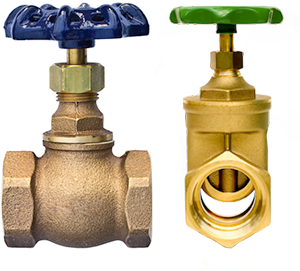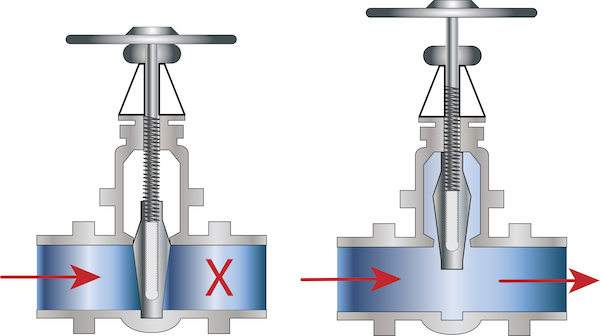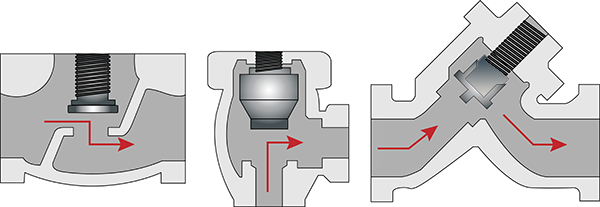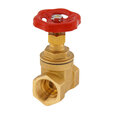Globe Valve vs Gate Valve

Figure 1: Globe valve (left) and gate valve (right)
Despite their similarities at first inspection, globe and gate valves have significant differences that make each suitable for their applications. When choosing between these two valves for an application, understanding the application's pressure, sealing, and flow requirements can ensure the correct valve is selected. This article discusses the differences between globe and gate valves to allow an educated decision before choosing between the two valves.
Table of contents
- Globe valve vs gate valve comparison
- Advantages and disadvantages chart
- Selecting between globe valves and gate valves
- Example applications
- FAQs
View our online selection of globe and gate valves!
Globe valve vs gate valve comparison
Globe valves and gate valves are multi-turn, linear motion valves, meaning both valves require multiple turns to open or close. The closing mechanism moves up and down in a straight line to turn open or close the valve. At this point, similarities between the valves begin to diminish.
The globe valve differs from most valves because its name derives from its body shape (rounded) rather than its disc, which is the gate valve's convention. Its disc moves up and down to allow or block the flow, similar to a gate. Read more on globe valves and gate valves to get a comprehensive understanding of both.
Flow properties
As seen in Figure 2, a gate valve is a straight-through, bi-directional valve, meaning its design permits flow directly through it in both directions. The only change to the flow occurs when the gate valve is closed, and the flow stops.

Figure 2: A gate valve flow properties when it is closed (left) and open (right).
A globe valve, on the other hand, has more turns for the flow path. As seen in Figure 3, the flow can take a z-shaped path (T- or Z-valve), an oblique path (Y-valve), or a 90° turn path (angle valve).
Because a globe valve diverts flow in a specific way, it has an inlet and an outlet port. Typically, an arrow on the outside of the valve's body will indicate the valve's flow direction. Also, the flow diversion causes a significant pressure drop through the globe valve. In contrast, a gate valve's pressure drop is nearly non-existent.

Figure 3: Globe valves' flow paths: T- or Z-valve (left), angle valve (center), and Y-valve (right)
Valve functions
Both gate valves and globe valves can operate as on/off valves. A gate valve is not meant to bused to throttle flow, but a globe valve can. Flow diverts within the globe valve and becomes parallel to the valve seat. This design makes globe valves efficient flow throttlers. Globe valves become unsuitable for throttling flow at larger diameters (above DN 150). Gate and globe valves can be operated mechanically, pneumatically, or electrically.
Note: With other factors equal, Y-valves are the least efficient at throttling flow because the valve seat is not parallel to the flow direction. However, this also means that Y-valves have the smallest pressure drop.
Visual differences
At a quick glance, gate valves and globe valves are not easy to tell apart. The following traits are what to look for to tell the difference:
- Body: Gate valves usually have a rectangular or wedge-shaped body. Whereas the body of a globe valve is rounder, especially at its bottom.
- Maximum height: Gate valves usually are higher when opened than globe valves.
- Flow direction indicator: Gate valves are bi-directional, whereas globe valves are unidirectional. A marker on the valve, such as an arrow, indicates the flow direction and that it's a globe valve.
Advantages and disadvantages chart
Globe and gate valves may have similar or different materials for their housing and seals. Read our chemical resistance guide to learn more about the advantages and disadvantages of the various materials. See the following chart to learn about more advantages and disadvantages.
Table 1: Globe valve and gate valve advantages and disadvantages chart
| Globe valve | Gate valve | |
| Application | Used for flow regulation (e.g., cooling water systems and fuel oil systems) | More suitable for slurry due to less space in the valve's body for sediment to get stuck and build up |
| Flow control | Can be used or on/off control and can throttle flow | Can be used for on/off control and cannot regulate the flow |
| Flow capacity | Lower | Higher |
| Flow direction | Unidirectional | Bi-directional |
| Flow restriction/pressure drop | Flow diversion within the valve's body creates significant pressure drop | Full-bore valve, meaning there is no reduction to flow and pressure drop is insignificant |
| Power requirement | Needs a large amount of force or an actuator to close under high pressure | Needs less power to close under high pressure |
| Operating conditions | Can operate at higher temperatures | Can operate at higher pressures |
| Cost | More expensive than a gate valve due to its complicated structure | Cheaper |
| Leakage | More effective sealing because force is applied to the disc when closed | Good sealing properties |
| Installation space | Takes up less vertical space, but requires more horizontal space | If a rising-stem style, needs more vertical space, but less horizontal space |
| Weight | Heavier | Lighter |
| Ports | Can have a 3-port configuration for straight-through flow | Two ports |
Selecting between globe valves and gate valves
Gate valves and globe valves are both excellent shut-off valves. However, when choosing between them, neither valve will outperform the other in every single application. Consider the following factors:
- Flow control: Select a globe valve if an application requires flow modulation.
- Flow capacity: Choose a gate valve if an application demands high flow.
- Flow direction: Choose a gate valve if an application requires bi-directional flow.
- Pressure drop: Select a gate valve if a minimal pressure drop is necessary.
- Sealing: If an application demands excellent sealing, select a globe valve.
- Contaminated media: Choose a gate valve if an application has slurry or other contaminated media.
The above variables are typically the most important when selecting a shut-off valve. Refer to Table 1 for further information.
Example applications
Globe valves
- Cooling water systems: Globe valves operate in cooling water systems by controlling the water flow to maintain a desired temperature.
- Chemical injection systems: Globe valves work well in industrial systems that need control over chemicals into reaction vessels or process streams.
Gate valves
- Bulk material handling systems: Heavy-duty processes (e.g., mining, agriculture, and construction) use gate valves to control the flow of bulk materials such as grains, coal, and aggregate.
- Water distribution systems: Many components of a water distribution system do not require precise flow control. Therefore, gate valves are suitable because they either block or allow flow.
FAQs
Which is better? A gate valve or a globe valve?
Globe valves have better sealing than gate valves and last longer. However, gate valves have significantly lower pressure drop.
What is the advantage of gate valves over globe valves?
One significant advantage of gate valves over globe valves is that they require significantly less power to close since they close perpendicular to flow rather than parallel as globe valves do.





